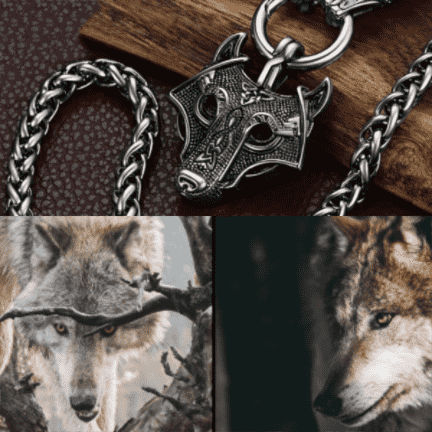How Animals Shape Metaphysical Beliefs in Viking Culture
Animals in Viking culture weren't merely creatures of the earth; they were powerful symbols, each embodying unique traits and mystical qualities. In the world of ancient Nordic culture, the interconnectedness between animals and spiritual significance was paramount. This profound connection extended to their craftsmanship, particularly in the creation of Viking jewelry. Beyond mere adornments, these artifacts reflected a deep reverence for animals, each embodying symbolic meanings that were intricately woven into the essence of Viking culture.
Now let's explore the metaphysical world of animals in Viking beliefs, unveiling the deeper meanings behind their presence.

The Wolf: Symbol of Strength and Loyalty
Central to Viking mythology, the wolf held a prominent place in their folklore. Depicted as Fenrir, the powerful wolf in Norse mythology, these creatures symbolized strength, resilience, and loyalty. Viking jewelry often featured intricately designed wolf motifs, harnessing the fierce energy associated with these majestic animals. For Vikings, wearing jewelry adorned with wolf symbols wasn't just a fashion statement; it was a manifestation of their intrinsic values – resilience in the face of adversity and unwavering loyalty to their kin.

The Raven: Emblem of Wisdom and Mysticism
In Viking lore, the raven was a creature of great significance, symbolizing wisdom, intelligence, and mysticism. Associated with the Norse god Odin, who was accompanied by two ravens, Huginn and Muninn, the raven held a revered place in Viking mythology. Jewelry adorned with raven motifs carried a sense of enigmatic charm, often representing an individual's pursuit of knowledge, their connection with the spiritual realm, and the constant quest for wisdom.

The Eagle: Symbol of Freedom and Wisdom
The eagle, associated with the Norse god Odin, represented wisdom, foresight, and the pursuit of knowledge. It was believed that Odin used eagles as messengers, signifying their connection to higher realms. Vikings revered the eagle as a symbol of strength, courage, and freedom. Carved into jewelry and other artifacts, the eagle motif held a prominent place in Viking culture, embodying their pursuit of spiritual enlightenment.

The Dragon: Symbol of Power and Transformation
Among the most enigmatic creatures in Viking mythology was the dragon. It embodied power, ferocity, and the ability to transform. Dragons were believed to guard treasures and represent the cycle of life, death, and rebirth. To the Vikings, adorning dragon-inspired jewelry or invoking its essence signified embracing change and tapping into hidden strengths.

The Serpent: Guardian of the Underworld and Cycles of Life
Serpents held significant symbolism in Viking culture, representing cycles of life, death, and rebirth. The most famous depiction is Jörmungandr, the Midgard Serpent, who encircled the world and represented chaos and order intertwined. Vikings believed in the cyclical nature of life, and the serpent served as a reminder of the eternal cycles and the inevitability of change.

Understanding The Animal Spirit: Metaphysical Meanings of Viking Creatures
The metaphysical significance of animals in Viking culture has left an indelible mark on our understanding of spirituality and symbolism. In contemporary contexts, people draw inspiration from Viking animal symbolism for tattoos, jewelry, and even spiritual practices. Many still seek guidance from these ancient animal spirits, connecting with their energy and wisdom. Viking animal jewelry is particular popular among enthusiasts.
In a way, the metaphysical significance of animals within Viking jewelry transcends mere aesthetic appeal. It embodies a deeper connection to the natural world, drawing upon the symbolism of animals to convey traits of strength, wisdom, resilience, and transformation. Each piece of Viking-inspired jewelry serves as a tangible link to the cultural reverence for these creatures, whether it's a pendant with wolf motifs, earrings featuring raven designs, or bracelets adorned with bear symbols, which allows wearers to connect with the enduring spirit of Viking culture, and to carry forth the timeless spirit of the Vikings in their modern-day endeavors.
As we can see that animals hold a profound place in the world of Metaphysics, serving as potent symbols of wisdom, transformation, intuition, and protection. Their timeless significance transcends cultures and beliefs, guiding seekers on spiritual journeys and offering insights into the deeper mysteries of life and the universe.



